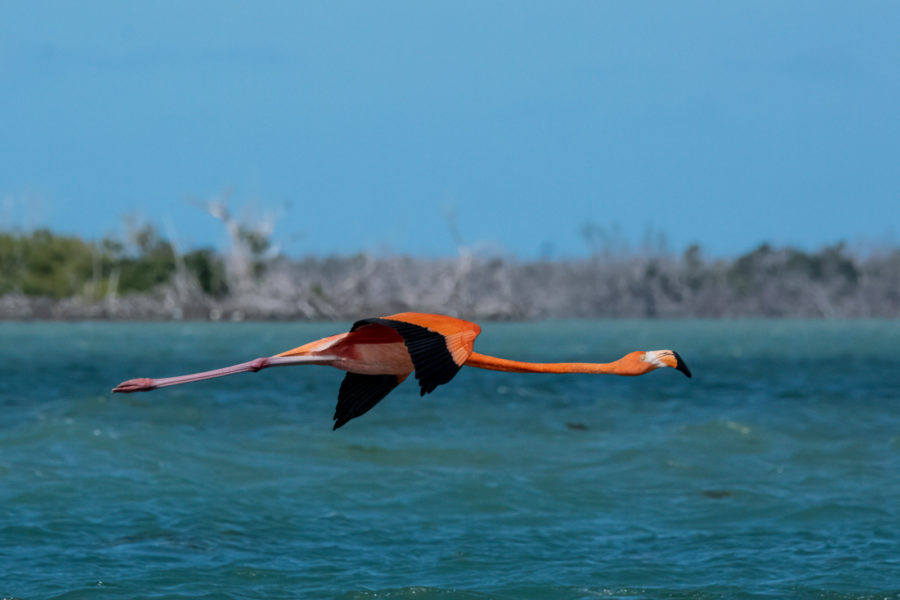It is surprisingly difficult to see a flamingo in Florida, at least a wild one. We get flamingos in the Florida Keys, specifically American flamingos, but not often. Once or twice in the Lower Keys on a good year, though we’ve been on a streak of late – three sightings in 18 months.
This third sighting placed me on West Summerland Key the other day, handing the contents of my pockets to my wife.
I’ve been lucky enough to see flamingos in the Keys and the Everglades several dozen times, but it doesn’t matter. I will drive a medium distance to see a flamingo nearly any time one shows up around here, because they are just so astoundingly weird.
I’ve been thinking deeply scientific thoughts lately about whether a flamingo is structured more like a goose with a snake grafted on for a neck, or like a miniaturized giraffe with wings. I’ve been leaning toward the grafted-snake idea. The neck moves so much differently than most birds’. It seems extraordinarily loose and flexible as if boneless, like a haunted rope.
No doubt this has something to do with how flamingos eat with their heads upside-down between their feet, filtering water through their bills with massively powerful tongues. (Their tongues are so powerful that in olden times they were considered a delicacy.) But still.
Also, how, how, how is something that lives in the real world that freaking pink? I know it’s the result of carotenoids from the brine shrimp and algae that make up the bulk of their diet. But how is that the best color for their survival and evolution as a species?
These physiological traits shouldn’t add up to a highly functioning creature, but they do.
Flamingos were not always this scarce. John James Audubon said he saw a good number of them here in the 1830s. In the 1850s a man named Gustav Würdeman wrote a letter, published posthumously by the Smithsonian Institute, describing a canoe expedition near Islamorada, where he and a local captain captured 100 flamingoes from a flock of about 500. In 1901, Judge E.R. Lowe stumbled across a breeding colony of 40 to 50 nests on Sugarloaf Key.
There aren’t many hard and fast numbers about historical flamingo populations in Florida, but there is strong consensus that their numbers plummeted to near zero after the early 1900s plume-hunting era, when a flamingo skin would fetch the equivalent of $700 today. The population has never really recovered.
For the longest time any flamingo seen in Florida was thought to be an escapee from a zoo or the Hialeah Park Race Track, though several sightings in more recent times indicate that may not be the case.
The West Summerland Key flamingo had shown up two days before, reported on eBird by a couple visiting from Texas. It had been hanging around a place informally known as the Horseshoe, most likely a borrow pit for the construction of the railroad or the highway, though its history is not totally clear. (Get to work, history columnist Brad Bertelli.) I’m not sure how deep the pit was, but it was called the horseshoe because it has two skinny spits of land on either side. The bird was out at the end, a quarter mile away, a pink dot surrounded by green waves.
I’d taken decent photos of a flamingo before. But can you ever really take enough decent photos of flamingos? I think not.

This one was too far for a great photo. You could walk out on the spit east of the borrow pit and get closer, but the bird would have been in bad light. The spit on the western side was disconnected from the beach, but looked wadeable. So after I gave my wife my wallet and keys, I dropped my camera into a Winn Dixie shopping bag – the fancy, reusable kind, not the disposable kind – and started out.
Within 10 steps I was up to my chest in water, holding the Winn Dixie bag on my shoulder. I thought about turning back, but kept at it until it got shallower.
Once on the spit, I moved slowly. There was a group of royal terns out at the end of the spit, and I figured if I could avoid flushing them, I wouldn’t flush the flamingo.
When I’d halved the distance to the flamingo I figured I was close enough.
The flamingo was slowly pacing between the ends of the horseshoe. It was windy, and when he got close I would take shots, laying down in the seaweed to get low and convey the scale of the waves. I steadily filled my memory card.
At one point a kiteboarder got close, did one of those high leaps and slapped his board down about 50 yards from the flamingo. The bird took off in the ungainly way they do, flapping at first, and when it had a little elevation, slapping its webbed feet on the surface of the water until fully airborne.
The bird banked and flew off in the opposite direction of the kiteboarder, 100, 200, 400 yards away, and I figured that was it. Who knew when we’d get to see another flamingo? But then it banked again, flew a couple loops around the horseshoe, and landed in its original spot.
I had a chance to appreciate its in-flight weirdness, the way it looked as if it could fly forward or backward without much difference, the way the neck didn’t seem to be supporting the head so much as acting like a swinging gangway between two nearly independent entities, the way the bird made me question my whole understanding of how the world works.


























